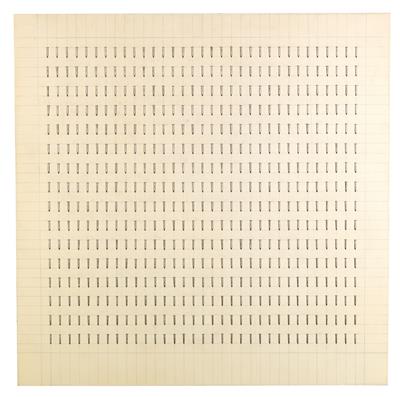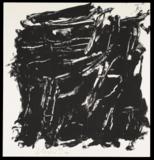Günther Uecker *

(born in Wendorf in 1930)
Reihung (Row), 1970, pencil, nails, lacquer, wooden panel, signed, dedicated on the reverse Uecker Günther “für Tünn und Eva” and with a directional arrow pointing to “lenk mack pfahler uecker - 35. biennale di venezia padiglione tedesco” on an adhesive note, 78 x 78 cm, in plexiglass box 79.5 x 79.5 x 5 cm, (PS)
Photo certificate issued by the artist.
Provenance:
Galerie m, Bochum
European Private Collection
“My attempt to activate a real space through structuring rows, to allow the observer to experience it as a condition of pure objective aesthetics, leads me to new design materials. When I use nails as structural elements I don’t want them to be understood as nails. What I’m trying to do is to create vibrations by using these materials in an ordered relationship to one another, one that disturbs the geometric order and may even irritate.“
Die Schönheit der Bewegung, 1961, in: Günther Uecker, Schriften, 1979, p.105
“To render the development of a movement visible as a dynamic state is a significant action. It is not a matter of routine but fertile in its repetition, in its very monotony, like the experience of prayer. My objects constitute a spatial reality, a zone of light. I use the means of technology to overcome the personal gesture, to objectify, to create the conditions for freedom.“
Günther Uecker, in: ZERO 3, Düsseldorf 1961; Reprint ZERO 1-3, Heinz Mack und Otto Piene, Cologne 1973, p. 220
Together with Thomas Lenk, Heinz Mack and Georg Karl Pfahler, Günther Uecker participated in the exhibition, curated by Dieter Honisch, of the German Pavilion at the 35th Venice Biennale. The exhibition catalogue for the German Pavilion was created in collaboration with the photographer and friend of Uecker, Tünn Konerding. Günther Uecker dedicated the work “Reihung“ to him and his wife Eva. Graphics by the four artists were attached to the exhibition catalogue, while the embossed printing of Günther Uecker again takes up the motif of the serial sequence and the type of the planar nailing. The works of Günther Uecker exhibited at the Biennale convey more clearly than those of the other artists the awareness of a radical change between the 1960s and the 1970s. Already in 1970 Uecker was the only one to take a stance against the formalism of the 1960s, a stance which declared art to be a field of free, human activity.
The goal was not the work of art in itself, but rather the acting, self-realising artist. The newly won freedom from formal or visual constraints also clearly manifested itself in the spontaneously agitated fields of nails and nail-objects which were created after 1970. The “Reihung“ is one of the numerous ideas of this period which Günther Uecker realised; in so doing, he in no way went over the already developed basic forms only to vary them, but instead he introduced completely new and fresh impulses into his work. The realisation of his ideas demanded a lot from Günther Uecker, and in his friends Tünn Konerding and Peter Dibke he found active supporters, not only with regard to the solution of technical problems but also in their artisanal execution.
The “Reihung“ is evidently a work which was constructed with the greatest attention to detail. Günther Uecker applies a geometric linear grid to the white-painted canvas; at the grid‘s intersections, 528 nails of completely identical length are hammered in and bent at right angles. In this work, the picture surface extends only minimally into the three-dimensional space via the bent nails. The exact, rhythmic alternation of nails and open areas structures the entire image surface down to the last detail, whereby, according to the incidence of light and the position of the viewer, new perspectives are opened up, which seemingly cause the picture to vibrate, although in fact everything remains static.
01.06.2016 - 19:00
- Realized price: **
-
EUR 344,600.-
- Estimate:
-
EUR 250,000.- to EUR 350,000.-
Günther Uecker *
(born in Wendorf in 1930)
Reihung (Row), 1970, pencil, nails, lacquer, wooden panel, signed, dedicated on the reverse Uecker Günther “für Tünn und Eva” and with a directional arrow pointing to “lenk mack pfahler uecker - 35. biennale di venezia padiglione tedesco” on an adhesive note, 78 x 78 cm, in plexiglass box 79.5 x 79.5 x 5 cm, (PS)
Photo certificate issued by the artist.
Provenance:
Galerie m, Bochum
European Private Collection
“My attempt to activate a real space through structuring rows, to allow the observer to experience it as a condition of pure objective aesthetics, leads me to new design materials. When I use nails as structural elements I don’t want them to be understood as nails. What I’m trying to do is to create vibrations by using these materials in an ordered relationship to one another, one that disturbs the geometric order and may even irritate.“
Die Schönheit der Bewegung, 1961, in: Günther Uecker, Schriften, 1979, p.105
“To render the development of a movement visible as a dynamic state is a significant action. It is not a matter of routine but fertile in its repetition, in its very monotony, like the experience of prayer. My objects constitute a spatial reality, a zone of light. I use the means of technology to overcome the personal gesture, to objectify, to create the conditions for freedom.“
Günther Uecker, in: ZERO 3, Düsseldorf 1961; Reprint ZERO 1-3, Heinz Mack und Otto Piene, Cologne 1973, p. 220
Together with Thomas Lenk, Heinz Mack and Georg Karl Pfahler, Günther Uecker participated in the exhibition, curated by Dieter Honisch, of the German Pavilion at the 35th Venice Biennale. The exhibition catalogue for the German Pavilion was created in collaboration with the photographer and friend of Uecker, Tünn Konerding. Günther Uecker dedicated the work “Reihung“ to him and his wife Eva. Graphics by the four artists were attached to the exhibition catalogue, while the embossed printing of Günther Uecker again takes up the motif of the serial sequence and the type of the planar nailing. The works of Günther Uecker exhibited at the Biennale convey more clearly than those of the other artists the awareness of a radical change between the 1960s and the 1970s. Already in 1970 Uecker was the only one to take a stance against the formalism of the 1960s, a stance which declared art to be a field of free, human activity.
The goal was not the work of art in itself, but rather the acting, self-realising artist. The newly won freedom from formal or visual constraints also clearly manifested itself in the spontaneously agitated fields of nails and nail-objects which were created after 1970. The “Reihung“ is one of the numerous ideas of this period which Günther Uecker realised; in so doing, he in no way went over the already developed basic forms only to vary them, but instead he introduced completely new and fresh impulses into his work. The realisation of his ideas demanded a lot from Günther Uecker, and in his friends Tünn Konerding and Peter Dibke he found active supporters, not only with regard to the solution of technical problems but also in their artisanal execution.
The “Reihung“ is evidently a work which was constructed with the greatest attention to detail. Günther Uecker applies a geometric linear grid to the white-painted canvas; at the grid‘s intersections, 528 nails of completely identical length are hammered in and bent at right angles. In this work, the picture surface extends only minimally into the three-dimensional space via the bent nails. The exact, rhythmic alternation of nails and open areas structures the entire image surface down to the last detail, whereby, according to the incidence of light and the position of the viewer, new perspectives are opened up, which seemingly cause the picture to vibrate, although in fact everything remains static.
|
Buyers hotline
Mon.-Fri.: 10.00am - 5.00pm
kundendienst@dorotheum.at +43 1 515 60 200 |
| Auction: | Contemporary Art - Part I |
| Auction type: | Saleroom auction |
| Date: | 01.06.2016 - 19:00 |
| Location: | Vienna | Palais Dorotheum |
| Exhibition: | 21.05. - 01.06.2016 |
** Purchase price incl. buyer's premium and VAT
It is not possible to turn in online buying orders anymore. The auction is in preparation or has been executed already.
More objects by this artist
-

Starting bid:
EUR 340.- -

Starting bid:
EUR 300.-
